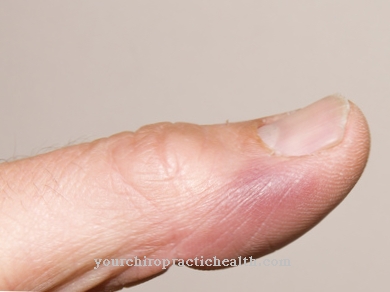The Pityriasis rubra pilaris (PRP) is a very rare skin disease that is often confused with psoriasis. Despite similar symptoms, this syndrome is a group of different skin diseases that are unrelated to one another. Pityriasis rubra pilaris usually heals on its own.
What is pityriasis rubra pilaris?

© Romanenko - stock.adobe.com
Pityriasis rubra pilaris represents a collective term for different skin diseases with the same symptoms. In rare cases, a gene mutation can be the cause. However, the cause is usually unclear. The pityriasis rubra pilaris is also called Prickleworm or Devergie disease designated. It was first described in 1856 by the Parisian dermatologist Marie Guillaume Devergie.
The disease is very rare. In the medical literature it is given with a probability of 1 in 1,000,000 or 1 in 500,000. Pityriasis rubra pilaris is not a dangerous disease. But it is characterized by the appearance of itchy skin nodules on the trunk and head. Often it starts from the hair follicles. The skin irritations appear spotty, with a smooth transition to a flat skin rash (erythroderma). In most cases, the disease occurs between the ages of 40 and 60.
causes
The causes of pityriasis rubra pilaris are in most cases not known. Originally, it was assumed that there was a uniform disease that was hereditary. Today it is known that only around five percent of all cases are clearly hereditary. Mutations in the CARD14 gene at gene location 17q25.3 are believed to be responsible for the disease. The inheritance is autosomal dominant. However, there are also sporadic cases. However, this gene mutation causes an atypical juvenile form of the disease.
Furthermore, if this gene is inherited dominantly, the disease should not always break out. Rather, it has been found that there are six different types of Pityriasis rubra pilaris:
- the classic adult type
- the atypical adult type
- the classic juvenile type
- the circumscribed juvenile type
- the atypical juvenile type
- the HIV-associated PRP
Most cases of pityriasis rubra pilaris are not hereditary. However, the exact genesis of the disease is not known. The very rare hereditary form is considerably more difficult to treat than the other forms. A connection to skin cancer is suspected in the classic adult type.
However, the incidence of skin cancer when this type occurs is also unknown. Some research suggests an abnormality in the processing of vitamin A as the cause of pityriasis rubra pilaris. But an incorrect reaction of the immune system is also taken into account.
Symptoms, ailments & signs
Pityriasis rubra pilaris is manifested by bright red, pointed nodules on the trunk, head and the extensors of the extremities. There are also scaly erythema on the skin. The nodules usually start on the hair follicles. There is normal skin between the nodes, making the skin irritation appear blotchy. The affected areas of the skin feel rough and have a grating sensation. There is also increased callus formation on the skin.
On the palms of the hands there is not only increased callus formation but also crack-like tears in the skin (rhagades). There is constant moderate itching. General reddening of the skin can occur in the acute phase. At no time, however, do general symptoms such as fever or fatigue occur. However, the course of the disease depends on the existing type. In the most common classic adult type, the disease only begins in adulthood.
The symptoms subside on their own after a few years and only occur again in exceptional cases after a certain time. In the atypical adult type, the symptoms also appear in adulthood. But they can last twenty years or more before they go away. In the classic juvenile type, the symptoms appear in adolescence and usually disappear again within a year. Here, too, they can reappear later.
In the defined juvenile type, isolated symptoms occur even in children on the palms of the hands, elbows, knees and soles of the feet, which subside again during puberty. The atypical juvenile type of the disease is genetic. It begins before birth and lasts indefinitely. HIV-associated PRP is difficult to treat.
Diagnosis & course of disease
Pityriasis rubra pilaris is similar to psoriasis and can usually only be diagnosed using a skin biopsy. There are already indications of PRP if treatment of the alleged psoriasis does not lead to success.
Complications
With pityriasis rubra pilaris, those affected primarily suffer from various skin complaints. These primarily have a very negative effect on the patient's aesthetics and can significantly reduce them. In many cases, the patients suffer from inferiority complexes or from a significantly reduced self-esteem. Bullying and teasing can also occur and have a negative effect on the psyche of the person concerned.
As a rule, those affected also suffer from severe itching of the skin due to pityriasis rubra pilaris and also from fever. The patient also becomes tired and exhausted. The symptoms themselves can go away on their own. The symptoms subside, especially during puberty.
A causal treatment of pityriasis rubra pilaris is unfortunately not possible. With the help of creams and ointments, however, the symptoms of the disease can be significantly alleviated. As a rule, there are no particular complications. Light therapy is also possible and leads to a positive course of the disease. The life expectancy of the person affected is not affected by the disease.
Therapy & Treatment
Pityriasis rubra pilaris cannot be cured with treatment. However, the symptoms usually go away on their own. However, if there is skin irritation, topical creams and ointments containing urea and lactic acid help. This will keep the skin moist. When taking vitamin A orally, significant improvements in symptoms were observed in some cases.
Furthermore, drugs can be used that slow down the growth of skin cells. The retinoids acitretin or isotretinoin have proven themselves for this. They are given orally. UV light therapy with additional drug treatment also promises good results.
Outlook & forecast
The further course of pityriasis rubra pilaris is usually very dependent on when the disease is recognized and how severe it is in the person affected. For this reason, the person affected should ideally see a doctor as early as possible and initiate treatment so that there are no other complaints or complications.
Self-healing cannot usually occur in pityriasis rubra pilaris, so that treatment by a doctor is always necessary. If the disease is not treated at all, there is no improvement and the symptoms can spread to other parts of the body and thus significantly reduce the quality of life of the person affected.
The treatment of pityriasis rubra pilaris can significantly alleviate and limit the symptoms with the help of medication and various creams or ointments. However, a complete cure is not always possible, so that those affected keep getting sick from the disease. In general, a healthy diet in particular can have a positive effect on the further course of this disease and in some cases prevent it from occurring again. The life expectancy of the person affected is not reduced by this disease.
prevention
Since the causes of pityriasis rubra pilaris are not known, unfortunately no recommendations can be made for its prevention. In any case, the skin should also be examined for a possible skin cancer risk after the occurrence of PRP.
Aftercare
In most cases, those affected with pityriasis rubra pilaris have only a few and no special measures available for direct follow-up care. Those affected should consult a doctor at an early stage so that the disease does not lead to complications or other complaints in the further course. The earlier a doctor is contacted, the better the further course of the disease will usually be.
For this reason, those affected should ideally contact a doctor at the first symptoms and signs of the disease. In some cases, the symptoms go away on their own, so that no special follow-up care is necessary or possible. However, in some cases light therapy can alleviate the symptoms and improve the quality of life of the person affected.
Various medications can also be taken to alleviate the symptoms. Those affected should always pay attention to the correct dosage and regular intake of the medication. If you have any questions or are unclear, you should always contact a doctor first. In most cases, pityriasis rubra pilaris does not reduce the life expectancy of the person affected and can be cured relatively easily.
You can do that yourself
Various, rarely occurring skin diseases are summarized under the term Pityriasis rubra pilaris, but they are harmless in themselves. Nevertheless, those affected often suffer greatly from them. This is mainly due to the pustules, which also appear in visible areas of the body and sometimes severely disfigure the patient. Young patients may be bullied or teased, but older patients with pityriasis rubra pilaris can also lose self-esteem.
Therefore, psychotherapy or behavioral therapy is recommended as an accompanying treatment. Many of those affected also found group therapy helpful because it enabled them to better understand and assess the reactions of their fellow human beings. Basically, patients suffering from pityriasis rubra pilaris should regularly care for their skin with the ointments prescribed for them. Oil baths, lotions containing urea and / or lactic acid and gentle peelings can also improve the complexion and reduce itching. Some patients have also had good experiences with UV light therapies.
Eating a healthy diet is always helpful for skin diseases. Ready-made products and fast food containing fat and sugar are often associated with skin lesions. It is therefore worthwhile to use fresh foods that are rich in vitamins, as they support the healing process. Since the body detoxifies through the skin, among other things, it is advisable to avoid toxins such as nicotine and alcohol.




.jpg)

.jpg)




















